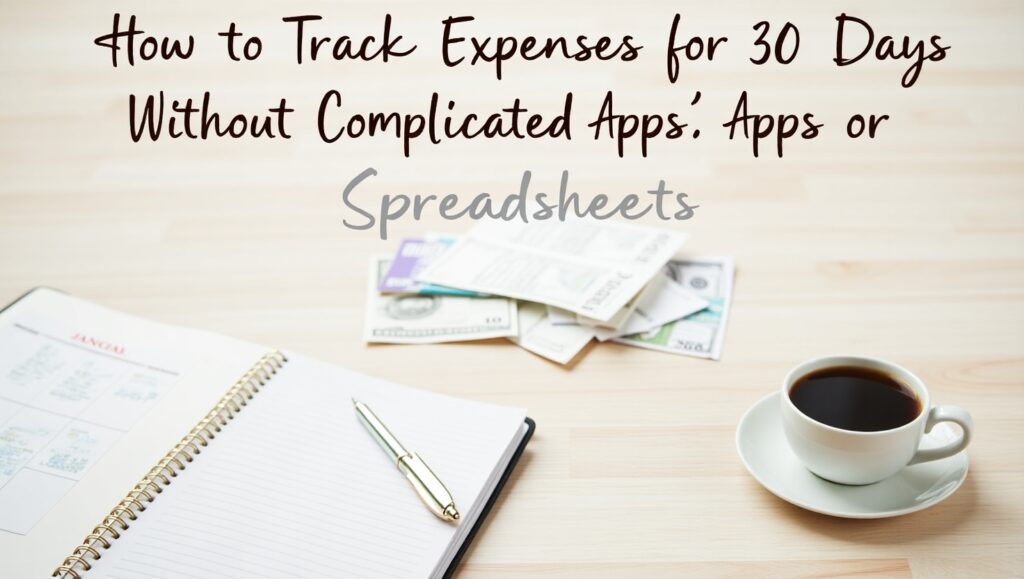Financial Disclaimer: I am not a financial advisor or consultant. The information shared in this article is based on my personal research and learning journey through books, podcasts, and educational content. All advice provided represents my opinions and experiences as someone exploring financial freedom. Please consult with a qualified financial professional before making significant financial decisions.
Quick Summary: Simple 30-Day Expense Tracking Methods
Before diving into the full guide, here are the key methods you’ll learn:
- The Paper Trail Method – Using a simple notebook to record every expense
- The Cash Envelope System – Physical cash allocation for spending categories
- The Receipt Collection Strategy – Systematic receipt organization and analysis
- The Daily Check-In Routine – 5-minute daily expense reviews
- The Photo Documentation Method – Using your phone camera for instant tracking
Have you ever wondered where your money disappears to each month? If you’re like most people starting their financial journey, the answer is probably a frustrating “I have no idea.” According to recent data from Fortunly’s personal finance statistics, only 36% of U.S. households had a long-term financial plan in 2024, and many struggle with basic expense awareness.
I’ve been there too. After months of reading financial books and listening to podcasts, I realized that complicated budgeting apps and intimidating spreadsheets were actually preventing me from understanding my spending habits. Therefore, I discovered that the simplest methods often work best for beginners who want to track expenses for 30 days without getting overwhelmed.
Related Reading: For more foundational budgeting concepts, check out this comprehensive guide on envelope budgeting from NerdWallet.
Why Most People Struggle With Expense Tracking
Before exploring simple solutions, let’s understand why traditional methods fail. Furthermore, recognizing these common pitfalls will help you avoid them during your 30-day tracking journey.
The App Overwhelm Problem
Many expense tracking apps promise to revolutionize your finances, but they often create more problems than they solve. Specifically, these digital tools frequently require:
- Complex categorization systems
- Constant smartphone notifications
- Bank account linking (which many beginners avoid)
- Learning curves that discourage consistent use
The Spreadsheet Intimidation Factor
Similarly, spreadsheets can feel overwhelming to beginners. Moreover, the technical requirements and formulas needed for effective tracking often discourage people before they even start.
The Perfectionism Trap
Most importantly, many people abandon expense tracking because they believe they must capture every single penny perfectly. However, this perfectionist mindset leads to frustration and eventual abandonment of the entire process.
Method 1: The Paper Trail System
The most straightforward approach to expense tracking involves nothing more than a pocket-sized notebook and a pen. Additionally, this method has worked for generations and remains highly effective for beginners.
Setting Up Your Paper System
First, choose a small notebook that fits comfortably in your pocket or purse. Next, divide each page into simple columns:
- Date
- Amount
- What I bought
- Category (optional)
Making It Work Daily
Every time you make a purchase, immediately write it down. Furthermore, don’t worry about perfect categorization initially—focus on capturing the basic information. Most importantly, carry your notebook everywhere and make logging expenses a non-negotiable habit.
Pro Tips for Paper Tracking
- Use a pen that won’t fade or smudge
- Review your entries each evening
- Don’t stress about perfect penmanship
- Keep backup pens available
Recommended Tool: The Moleskine Pocket Notebook works perfectly for this system and fits in most pockets.
Method 2: The Cash Envelope System
The concept is simple: Take a few envelopes, write a specific expense category on each one — like groceries, rent or student loans — and then put the money you plan to spend on those things into the envelopes, as explained by NerdWallet’s envelope system guide.
Creating Your Envelope Categories
Start with these basic categories for your first 30 days:
- Groceries
- Transportation/Gas
- Entertainment
- Dining Out
- Personal Care
- Miscellaneous
The Weekly Allocation Process
At the beginning of each week, allocate cash to each envelope based on your planned spending. Subsequently, track your expenses by watching how quickly each envelope empties.
Benefits of Physical Cash Tracking
The envelope system provides immediate visual feedback about your spending habits. Moreover, when an envelope is empty, you’re done spending in that category—creating natural spending limits.
According to research from Ramsey Solutions, you’re aiming for a zero-based budget where your income minus your expenses equals zero. This means you’re giving every dollar a job to do.
Method 3: The Receipt Collection Strategy
Instead of trying to track expenses in real-time, this method involves systematically collecting and analyzing receipts at the end of each day.
Daily Receipt Management
Create a simple system for receipt collection:
- Designate a receipt container – Use a small box or envelope at home
- Empty your wallet daily – Transfer all receipts to your container
- Weekly sorting sessions – Organize receipts by category
- Monthly analysis – Calculate totals and identify patterns
Organizing for Maximum Insight
During your weekly sorting sessions, group receipts into meaningful categories. Furthermore, look for patterns in your spending timing and locations.
Digital Enhancement Option
While staying simple, you can enhance this method by taking photos of receipts with your smartphone before filing them. This creates a backup system without requiring complicated apps.
Method 4: The Daily Check-In Routine
This method focuses on building a sustainable daily habit rather than complex tracking systems. Additionally, it requires only five minutes per day and builds powerful awareness over time.
The 5-Minute Evening Review
Each night before bed, ask yourself these three questions:
- What did I spend money on today?
- How much did I spend in total?
- Was this spending aligned with my goals?
Creating Your Check-In Log
Use a simple format in any notebook:
Date: [Today’s date] Total Spent: $[Amount] Biggest Purchase: [Item and amount] Feeling: [Good/Okay/Concerned about today’s spending]
Building the Habit
Start with just these basics and gradually add more detail as the habit strengthens. Most importantly, consistency matters more than perfection during your 30-day experiment.
Method 5: The Photo Documentation Method
Your smartphone camera can become a powerful expense tracking tool without downloading any specialized apps. Furthermore, this method works particularly well for visual learners.
The Photo System Setup
Create a simple photo-based tracking system:
- Photograph every receipt
- Take pictures of cash purchases (write amount on paper)
- Screenshot online purchase confirmations
- Organize photos into weekly folders
Weekly Photo Review Sessions
Schedule 15-minute weekly sessions to review your expense photos. During these sessions, add up totals and identify spending patterns. Moreover, this visual review often reveals surprising insights about your habits.
Backup and Organization
Create weekly folders on your phone labeled “Week 1 Expenses,” “Week 2 Expenses,” etc. This simple organization system makes monthly analysis much easier.
Creating Your 30-Day Tracking Plan
Now that you understand the methods, let’s create your personalized 30-day expense tracking plan. Moreover, choosing the right method for your lifestyle is crucial for success.
Week 1: Foundation Building
Start with just one method that feels most comfortable. Additionally, focus on building the habit rather than perfect execution. Most people find the paper trail or photo method easiest for beginners.
Week 2: Refinement
During the second week, refine your chosen method based on what you learned in week one. Furthermore, don’t switch methods—instead, improve your current approach.
Week 3: Pattern Recognition
By week three, you’ll start seeing spending patterns. Therefore, begin asking deeper questions about your expenses:
- Which days do I spend the most?
- What triggers my biggest purchases?
- Which categories consistently exceed my expectations?
Week 4: Analysis and Planning
The final week focuses on analyzing your data and planning improvements. Moreover, this analysis will inform your future budgeting and spending decisions.
Common Challenges and Solutions
Even simple expense tracking methods come with challenges. However, anticipating these obstacles helps you overcome them successfully.
Challenge 1: Forgetting to Track
Solution: Link tracking to existing habits. For example, track expenses while having your morning coffee or during your evening phone check.
Challenge 2: Inconsistent Categories
Solution: Keep categories broad initially. Use “Food,” “Transportation,” and “Other” instead of dozens of specific subcategories.
Challenge 3: Cash vs. Card Confusion
Solution: Treat all purchases the same way in your tracking system. Don’t create different processes for different payment methods.
Challenge 4: Weekend Spending Spikes
Solution: Plan specific times for weekend expense logging. Many people find Sunday evening works well for catching up on weekend purchases.
Analyzing Your 30-Day Results
After completing your 30-day expense tracking experiment, the real learning begins. Furthermore, proper analysis transforms raw data into actionable insights.
Calculating Key Metrics
Determine these essential numbers from your tracking data:
- Total monthly spending
- Average daily spending
- Highest spending category
- Most expensive single purchase
- Number of transactions per week
Identifying Spending Patterns
Look for patterns in your expense data:
- Time-based patterns – Do you spend more on certain days or times?
- Location patterns – Which stores or services get most of your money?
- Emotional patterns – Can you connect spending to your mood or stress levels?
Comparing to Your Expectations
Most people discover significant gaps between their perceived spending and actual spending. Therefore, document these surprises as they often represent the biggest opportunities for improvement.
Frequently Asked Questions
What if I forget to track expenses for a few days?
Don’t abandon the entire process—simply start again immediately. Moreover, try to reconstruct missed days using bank statements or credit card records, but don’t let perfection become the enemy of progress.
How detailed should my expense categories be?
For your first 30 days, keep categories broad and simple. Use 5-7 main categories maximum. Furthermore, you can always add more detail in future tracking periods once the basic habit is established.
Should I track every single penny?
Focus on transactions over $1-2 initially. Additionally, small purchases like gum or coffee shop tips don’t need to derail your entire tracking system. Build the habit first, then add detail later.
What if my expenses vary dramatically from month to month?
This is exactly why tracking is valuable—it reveals the reality of your spending patterns. Therefore, plan to track for multiple months to get a complete picture of your financial habits.
How do I handle shared expenses with roommates or family?
Track your portion of shared expenses consistently. For example, if you split a $40 dinner, record $20 in your tracking system. Moreover, note these as “shared” expenses for future reference.
Conclusion
Tracking your expenses for 30 days without complicated apps or spreadsheets is not only possible—it’s often more effective than high-tech solutions. Throughout my learning journey, I’ve discovered that simple methods create sustainable habits, while complex systems often lead to abandonment.
The key to success lies in choosing a method that fits your lifestyle and sticking with it consistently. Moreover, remember that awareness is the first step toward financial control. Your 30-day experiment will provide valuable insights that inform better financial decisions for years to come.
Start today with whichever method resonates most with you. Furthermore, remember that imperfect tracking is infinitely better than no tracking at all. Your future financially-aware self will thank you for taking this important first step.


